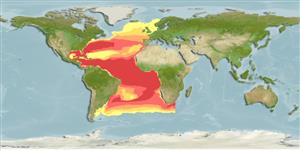>
Beloniformes (Needle fishes) >
Hemiramphidae (Halfbeaks)
Etymology: Euleptorhamphus: Greek, eu = good + Greek, leptos = thin + greek, rhamphos = bill, peak (Ref. 45335).
More on author: Poey.
Environment: milieu / climate zone / depth range / distribution range
Ecología
marino; rango de profundidad 0 - ? m. Tropical
Eastern Atlantic: Cape Verde, Sierra Leone, Gulf of Guinea and Nigeria. Western Atlantic: Rhode Island, USA and northern Gulf of Mexico to the Antilles (Ref. 26340) and Brazil (Ref. 7251); including the Caribbean Sea (Ref. 4497). Record from Namibia may belong to Indo-Pacific species Euleptorhamphus viridis.
Tamaño / Peso / Age
Maturity: Lm ? range ? - ? cm
Max length : 61.0 cm TL macho / no sexado; (Ref. 26340); common length : 35.0 cm TL macho / no sexado; (Ref. 5217)
Occurs in coastal and oceanic waters (Ref. 2683).
Life cycle and mating behavior
Madurez | Reproducción | Puesta | Huevos | Fecundidad | Larva
Collette, B.B. and N.V. Parin, 1990. Hemiramphidae. p. 579-582. In J.C. Quero, J.C. Hureau, C. Karrer, A. Post and L. Saldanha (eds.) Check-list of the fishes of the eastern tropical Atlantic (CLOFETA). JNICT, Lisbon; SEI, Paris; and UNESCO, Paris. Vol. 2. (Ref. 4497)
IUCN Red List Status (Ref. 130435: Version 2024-1)
Threat to humans
Harmless
Human uses
Pesquerías: comercial
Herramientas
Special reports
Download XML
Fuentes de Internet
Estimates based on models
Preferred temperature (Ref.
123201): 10 - 21.4, mean 15 °C (based on 258 cells).
Phylogenetic diversity index (Ref.
82804): PD
50 = 0.7500 [Uniqueness, from 0.5 = low to 2.0 = high].
Bayesian length-weight: a=0.00102 (0.00046 - 0.00225), b=3.06 (2.88 - 3.24), in cm total length, based on all LWR estimates for this body shape (Ref.
93245).
Nivel trófico (Ref.
69278): 3.1 ±0.2 se; based on size and trophs of closest relatives
Resiliencia (Ref.
120179): Alto, población duplicada en un tiempo mínimo inferior a 15 meses (Preliminary K or Fecundity.).
Fishing Vulnerability (Ref.
59153): Moderate vulnerability (44 of 100).
